The x86 Power Myth Busted: In-Depth Clover Trail Power Analysis
by Anand Lal Shimpi on December 24, 2012 5:00 PM ESTIdle Power
In all of these tests you're going to see three charts. The first will show you total platform power, measured at the battery, taking into account everything from SoC to display. The next shows you power measured at the CPU power delivery circuit, and the third shows you power measured at the GPU power delivery circuit. All values are measured in watts, and are reported in 15ms intervals (although I sampled at 1KHz then averaged down to 15ms).
For our first set of tests I simply wanted to get a feel for idle power. Both systems had all background syncing suspended, WiFi was connected, and we're just sitting at the Windows RT/8 Start Screen until the tablets reached a truly idle state. Note that idle under Windows RT/8 technically doesn't happen until the live tiles stop updating, which you'll see denoted by a drop in the idle power consumption in the graphs below.
First up is total platform power consumption:
Surface RT has higher idle power, around 28% on average, compared to Acer's W510. The last half of the graph shows the tablets hitting true idle when the live tiles stop animating.
A look at the CPU chart gives us some more granularity, with Tegra 3 ramping up to higher peak power consumption during all of the periods of activity. Here the Atom Z2760 cores average 36.4mW at idle compared to 70.2mW for Tegra 3.
The GPU specific data is pretty interesting - the GPU power rail shows much high power consumption than on Intel's Z2760. As I didn't design Tegra 3, I don't know what else is powered by this rail - although you'd assume that anything else not in use would be power gated. Imagination Technologies' PowerVR SGX 545 does appear to be quite power efficient here, on average using 155mW while rendering the Start Screen.
I wasn't happy with the peaks we were seeing when nothing was happening on the systems, so to confirm that nothing funny was going on I threw both tablets into airplane mode and waited for full idle. Check out the tail end of the platform power diagram:
That's much better. Without the AP talking to each tablet's WiFi radio constantly, idle becomes truly idle. If you're curious, the power savings are around 47.8mW (average) for the W510 in airplane mode when fully idle.
The GPU rail feeding the Atom Z2760 appears to hit a lower idle power when compared to NVIDIA's Tegra 3. Advantages in idle power consumption are key to delivering good battery life overall.


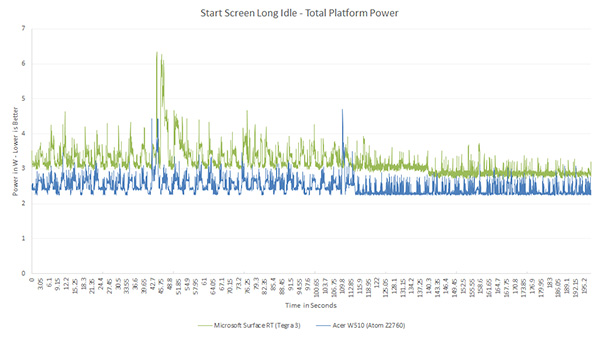
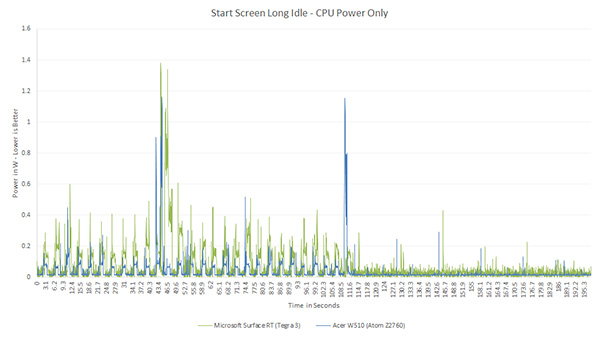
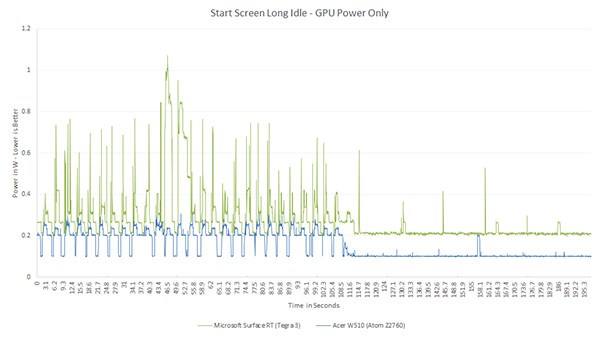

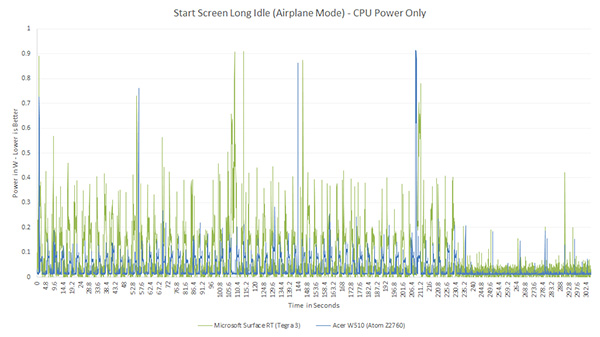
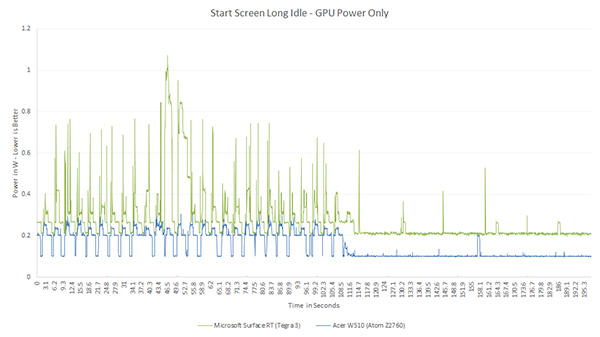








163 Comments
View All Comments
karasaj - Monday, December 24, 2012 - link
All they need to do is either put intel HD graphics (Haswell) or license a better gpu from Imagination, I imagine. Although ARM (Samsung?) have really been developing better GPUs lately, they seem to be catching up.jeffkibuule - Tuesday, December 25, 2012 - link
They've already stated they will be integrating a variant of their Intel HD 4000 GPU in their next-generation Atom SoC, the only question is how many Execution Units and what kind of power profile their will be targeting.With Intel, the question isn't so much about performance, but maximizing profits. If they build an Atom SoC that's so great and also cost competitive with other ARM chips, who would buy their more expensive Core CPUs? This is one reason why I believe that the Atom and Core lines will eventually have to merge, just like how the Pentium and Pentium M lines had to converge into the original Core series back in 2006 (oh, how the irony in history repeating itself).
lmcd - Tuesday, December 25, 2012 - link
It's more likely a variant of the 2500, which won't be enough. 4k doesn't even beat the 543MP3 does it?jeffkibuule - Tuesday, December 25, 2012 - link
There haven't really been any comparisons of mobile and smartphone GPUs yet. We'll have to wait for 3DMark for Windows 8 to get our first reliable comparison.wsw1982 - Tuesday, December 25, 2012 - link
I think it depends, 16 543MP3 cores should beat the 4K :) Single core 543MP3 is not better than 545.mrdude - Wednesday, December 26, 2012 - link
It's also a matter of TDP, though. The ARM SoCs pack a lot of punch on the CPU side but with often better GPU performance at an equal footing with respect to TDP (sub-2W for smartphones and ~sub-5W for tablets).As much as Intel wants to pound home the point that x86 is power efficient, it's an SoC and therefore a package deal. Intel still suffers from the lopsided design approach, dedicating far too much die space to the CPU with the GPU an afterthought. If you look at the more successful and popular/powerful ARM SoCs, it tends to be the other way around. A balanced approach with great efficiency is what makes the Snapdragon S4's such fantastic SoCs and why Qualcomm has now surpassed Intel in total market cap. The GPU is only going to become more and more important going forward due to PPI increasing drastically. At least for Apple, they've already reached a point where they're required to spend a huge portion of the die to the GPU with smaller, incremental bumps in CPU performance.
This really seems like Intel is shoehorning their old Atom architecture into a lower TDP, saying: "Look! It's efficient! Just don't pay any attention to the fact that we're comparing it to a 40nm Tegra 3 and don't you dare do any GPU benchmarks." These things are meant for tablets, are Intel not aware just how much MORE the GPU matters? Great perf-per-watt (maybe), but that's all for nothing if the SoC sucks.
somata - Monday, December 31, 2012 - link
As others have said, it'll be nice once we can do proper comparisons between tablet/notebook/desktop GPUs, but in the meantime just consider the peak shader performance of each:Intel HD 4000 - 16(x4x2) @ 1.3GHz - 333 GFLOPS
Intel HD 3000 - 12(x4) @ 1.3GHz - 125 GFLOPS
PowerVR SGX 543MP4 - 16(x4) @ 300MHz - 38.4 GFLOPS
PowerVR SGX 554MP4 - 32(x4) @ 300MHz - 76.8 GFLOPS
The PowerVR numbers are based off of Anand's analysis. Obviously not exactly a fair comparison, but clearly Intel's mainstream integrated GPUs are substantially more powerful than any current PowerVR design. Of course that shouldn't be a surprise given the TDP of each platform.
p3ngwin1 - Tuesday, December 25, 2012 - link
there are already smartphones with 1080P displays and Android tablets with even high resolutions :)coolhund - Tuesday, December 25, 2012 - link
Plus the Atom is not OoO, IO is known to use much less power. Plus the OS is not the same.Sorry, but for me this comparison is nonsense.
tipoo - Monday, December 24, 2012 - link
I'll be very interested to read the Cortex A15 follow up. From what I gather, if compared on the same lithography the A15 core is much larger than the A9, which likely means more power, all else being equal. It brings performance up to and sometimes over the prior generation Atom, but I wonder what power requirement sacrifices were made, if any.I'm thinking in the coming years, Intel vs ARM will become a more interesting battle than Intel vs AMD.